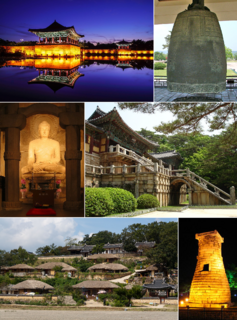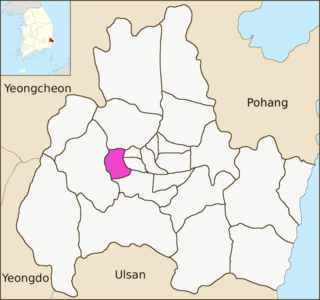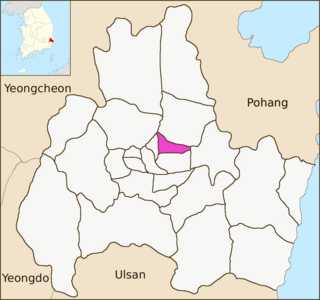
Gyeongju, historically known as Seorabeol, is a coastal city in the far southeastern corner of North Gyeongsang Province in South Korea. It is the second largest city by area in the province after Andong, covering 1,324 km2 (511 sq mi) with a population of 264,091 people Gyeongju is 370 km (230 mi) southeast of Seoul, and 55 km (34 mi) east of Daegu. The city borders Cheongdo and Yeongcheon to the west, Ulsan to the south and Pohang to the north, while to the east lies the coast of the Sea of Japan. Numerous low mountains—outliers of the Taebaek range—are scattered around the city.
Tourism in Gyeongju is a major industry and defining feature of Gyeongju, South Korea. Gyeongju is a major cultural site and tourist destination for South Koreans and foreigners with about 8 to 9 million visitors annually. A great deal of this is due to the city's status as a center of Silla heritage, derived from its former role as the capital of that ancient kingdom.

Gangdong-myeon is a myeon or a township of Gyeongju city in North Gyeongsang Province, South Korea. It is bordered by Pohang on the east and north, Cheonbuk-myeon on the south and Angang-eup on the west. In 2006 its population was 8,705 people, and its area is approximately 81.48 sq kilometers. Its name means "east of the river" although in fact much of it lies north of the Hyeongsan River.

Gampo-eup is an eup or a town of Gyeongju in South Korea. It contains part of Gyeongju National Park: the Daebon section which covers the shoreline near Daewangnueng, the watery grave of King Munmu of the Silla kingdom. 7,132 people live in Gampo-eup, served by two elementary schools and a joint middle-high school. Important local products include persimmons as well as anchovies, seaweed, and squid.

Angang-eup is an eup or a town and is the second-largest subdivision of Gyeongju City. Its 139 square kilometers are home to about 33,300 people, and is served by six elementary schools and two joint middle-high schools. Situated next to Gangdong-myeon in the city's northern tip, it is a significant town in its own right. Angang Station is a regular stop on the Donghae Nambu Line. The town center lies on the Hyeongsan River, near where it meets the small Chilpyeongcheon stream. Important local products include rice, apples, and grapes.

Oedong-eup is an eup or a town in the subdivision of the Gyeongju City, North Gyeongsang province, South Korea. Its 139 square kilometers are home to about 17, 500 people. It is linked by road and rail to the neighboring metropolis of Ulsan. Due to the feature, the town has been a center of the development of Gyeongju's automotive parts industry. Three industrial complexes are located here. This population is served by six elementary schools, a middle school, and a high school

Sannae-myeon is a myeon or a township in the subdivision of Gyeongju City, North Gyeongsang province, South Korea. Its 142.64 square kilometers are home to about 3,624 people. This population is served by one elementary school, two branch schools and a kindergarten affiliated with the elementary school, and one joint middle-high school.

Seo-myeon is a myeon or a township in the subdivision of the Gyeongju City, North Gyeongsang province, South Korea. It is bordered by its neighborhoods including Hyeongok-myeon and Geoncheon-eup on the east, Sannae-myeon on the south and Yeongcheon City on the west and north. Its 52.12 square kilometers are home to about 4,166 people. This population is served by one elementary school and one joint middle school.

Hyeongok-myeon is a myeon or a township in the administrative subdivisions of the Gyeongju City, North Gyeongsang province, South Korea. It is bordered by Hyeongsan River, Cheonbuk-myeon and Yonghwang-dong on the east, Bodeok-dong on the south and Geoncheon-eup on the southwest, Seo-myeon on the west and Angang-eup on the north. Its 55.74 square kilometers are home to about 13,658 people. This population is served by three elementary schools, one middle school and one high school.

Cheonbuk-myeon is a myeon or a township in the administrative subdivisions of the Gyeongju City, North Gyeongsang province, South Korea. It is bordered by Pohang city on the east, Bodeok-dong on the south, Angang-eup and Hyeongok-myeon to the boundary Hyeongsan River on the west and Gangdong-myeon on the north. Its 58.15 square kilometers are home to about 6,140 people. This population is served by two elementary schools, one high school.

Yangbuk-myeon is a myeon or a township in the administrative subdivisions of the Gyeongju City, North Gyeongsang province, South Korea. It is bordered by Gampo-eup and Sea of Japan on the east, Yangnam-myeon on the south, Bulguk-dong, Bodeok-dong and Oedong-eup on the west and Ocheon-eup and Janggi-myeon of the Pohang city on the north. Its 120.06 square kilometers are home to about 4,558 people. This population is served by one joint elementary-middle school.

Yangnam-myeon is a myeon or a township in the administrative subdivisions of the Gyeongju City, North Gyeongsang province, South Korea. It is bordered by the Sea of Japan on the east, the Ulju County of Ulsan Metropolitan City on the south, Oedong-eup on the west and Yangbuk-myeon on the north. Its 85.06 square kilometers are home to about 7,131 people. The Wolseong Nuclear Power Plant is situated in the myeon.

Naenam-myeon is a myeon or a township in the administrative subdivisions of the Gyeongju City, North Gyeongsang province, South Korea. It is bordered by Geumo Mountains on the east, Jusa Mountains on the south. Its 122.05 square kilometers are home to about 6,142 people. This population is served by one elementary school and one high school.

Seondo-dong is an administrative dong or neighbourhood in the administrative subdivisions of the Gyeongju City, North Gyeongsang province, South Korea. It consists of four legal dongs such as Seoak-dong, Chunghyo-dong, Hyohyeon-dong, and Gwangmyeong-dong. It is bordered by Seonggeon-dong and Tapjeong-dong on the east, Geoncheon-eup on the south and west and Hyeongok-myeon on the north. Its 28.00 square kilometers are home to about 13,587 people. This population is served by an elementary school, a middle school and a joint middle-high school, two high schools, a junior college, a university and a vocational school.

Seonggeon-dong is an administrative dong or a neighbourhood in the administrative subdivisions of the Gyeongju City, North Gyeongsang province, South Korea. It consists of four legal dongs including Seonggeon-dong and Seokjang-dong. It is bordered by Dongcheon-dong on the east, Geoncheon-eup on the west and Jungbu-dong on the south and Hyeongok-myeon on the north. Its 6.42 square kilometers are home to about 18,219 people. The Gyeongju branch campus of Dongguk University is situated in the district and it has an elementary school and a high school

Yonggang-dong is both an administrative and legal dong or a neighbourhood in the administrative subdivisions of the Gyeongju City, North Gyeongsang province, South Korea. It is bordered by Bukgun-dong on the east, Deoksan-ri of Cheonbuk-myeon on the northeast, Hwangseong-dong and Dongcheon-dong on the south and Geumjang-ri of Hyeongok-myeon on the south. Its 5.06 square kilometers are home to about 15,817 people. It has two elementary schools, a middle school and a high school

Bulguk-dong is an administrative dong or a neighbourhood in the administrative subdivisions of the Gyeongju City, North Gyeongsang province, South Korea. It consists of seven legal dong including Gujeong-dong, Sirae-dong, Si-dong, Joyang-dong, Jinhyeon-dong, Ma-dong and Ha-dong.
Tapjeong-dong was an administrative dong or a neighbourhood in the administrative subdivisions of the Gyeongju City, North Gyeongsang province, South Korea until January 2009. It consisted of four legal dong including Tap-dong, Sajeong-dong, Yul-dong, and Bae-dong.

Wolseong-dong is an administrative dong or a neighbourhood in the administrative subdivisions of the Gyeongju City, North Gyeongsang province, South Korea. It consists of nine legal dong including Inwang-dong, Gyo-dong, Dongbang-dong, Doji-dong, Namsan-dong, Pyeong-dong, Guhwang-dong, Bomun-dong and Baeban-dong




















